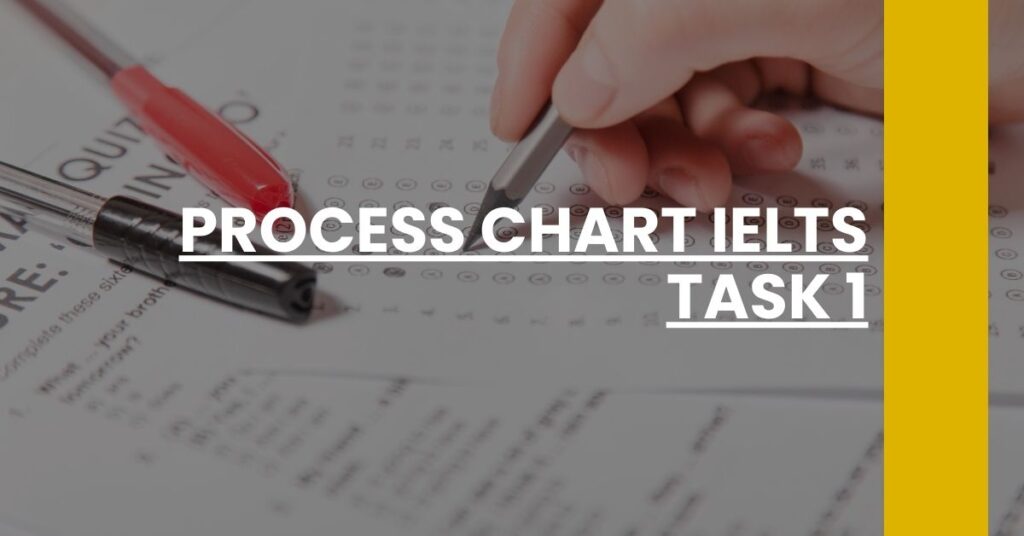Master the process chart IELTS Task 1 with tailored strategies.
- Essential Skills for the Process Chart: Hone the ability to describe process diagrams accurately.
- Vocabulary Enhancement: Expand your lexicon for a more precise depiction of processes.
- Structural Techniques: Learn the optimal organization for your essay’s clarity and impact.
Elevate your writing with process chart IELTS Task 1 insights.
- Understanding the Process Chart in IELTS Task 1
- Analyzing the Process Diagram
- Key Vocabulary for Describing Processes
- How to Structure Your Response
- Crafting an Effective Introduction
- Writing a Coherent Overview
- Detailing the Steps of the Process
- Connecting Ideas Fluently
- Common Mistakes to Avoid
- Practice Techniques for Process Chart Descriptions
- Reviewing Model Answers
- Conclusion
Understanding the Process Chart in IELTS Task 1
When you encounter a process chart on the IELTS Writing Task 1, you’re looking at a diagram that presents a sequence of actions leading to a specific outcome. Unlike graphs and tables that often deal with numerical data, a process chart serves to elucidate a flow of steps, typically in a natural or manufactured process.
Why is this important? Well, while you might feel comfortable explaining pie charts and bar graphs, process charts can throw even the most prepared test-takers for a loop. They require not only a good understanding of the process being described but a subtle hand in detailing each step without becoming repetitive or overlooking crucial details.
What’s the Difference?
At first glance, the biggest contrast between process charts and other IELTS visuals is their narrative nature. While a chart or graph displays trends over time, a process chart unfolds like a story, from the beginning to the end of a process.
Process Charts in IELTS: A Snapshot
- Visual versality: Process charts can depict anything from the life cycle of a frog to the manufacturing of glass bottles.
- No numbers game: You won’t find percentages or figures here, but you will need to describe the order and relationship between steps.
- Lexical challenge: They test your ability to use sequence markers and diverse vocabulary to explain a series of events efficiently.
By understanding these key differences, you’re already aligning your strategy to tackle process charts head-on during your IELTS writing task.
Analyzing the Process Diagram
Before you dive into writing, it’s crucial to take a moment to thoroughly analyze the process diagram presented to you. Start by identifying the beginning and end of the process. Often, an insightful glance can reveal whether the process is linear or cyclical. Now, break down the diagram into clearly defined stages. Understand that these are the building blocks of your essay.
Identifying the Stages
- First stage: Look for the starting point. It could be an input, or a raw material, and it’s where your description will begin.
- Subsequent stages: Follow the arrows or lines; they will guide you through the process, showing how one stage leads to another.
- Final Stage: Spot the endpoint. It’s the conclusion of the process, the moment the product is ready, or the process repeats.
Remember, the key to acing this part is an organized approach. Take note of any reoccurring cycles as well – they can be a significant feature to highlight in your writing.
Key Vocabulary for Describing Processes
Your grasp of vocabulary will determine how effectively you can describe the process chart. Since this isn’t a standard narrative essay, you’ll need a specialized set of words to convey the progression of steps.
Utilizing Action Words and Nouns
- Verbs: Often in the passive form, such as ‘is heated,’ ‘are mixed,’ or ‘is collected.’
- Nouns: Look for terms that denote steps or stages, like ‘stage,’ ‘phase,’ or ‘sequence.’
Expressing Sequence and Transition
- Sequence markers: Such as ‘initially,’ ‘then,’ ‘subsequently,’ or ‘finally.’
- Transition phrases: ‘Following this,’ ‘at this point,’ or ‘consequently.’
These terms are not just filler; they’re the linguistic glue that can hold your description together, creating a narrative that’s easy for the reader to follow. For an extensive list of vocabulary that can help, check out this useful resource.
How to Structure Your Response
A logically structured essay is vital for the reader to understand the chronological sequence or the process you’re describing.
The Blueprint of Your Essay
- Introduction: Paraphrase the question prompt to introduce the process chart.
- Overview: Summarize the entire process in two or three sentences, capturing the most significant stages.
- Body Paragraphs: Describe each stage in detail, following the natural order as you move from one paragraph to the next.
Keep these sections clear and distinct, as they serve different purposes within your response. Refer to models like this framework for guidance on constructing a well-organized essay.
Crafting an Effective Introduction
The introduction is where you set the stage for what’s to come. It should relay the same information that the diagram does but in your own words.
Steps to a Successful Start
- Restate the prompt: Show the examiner that you understand the chart by paraphrasing the question.
- Keep it brief: This isn’t the place to show off your vocabulary – clarity takes precedence.
Your introduction lays the foundation. A well-crafted one will help you lead smoothly into a coherent overview.
Writing a Coherent Overview
The overview serves as a roadmap for your response. It’s crucial to highlight the main steps without getting entangled in the specifics.
Outlining the Process
- Pinpoint key stages: Indicate the start, any critical junctures, and the endpoint.
- Avoid details: Save the minutiae for the body paragraphs.
Think of the overview as your chance to give the reader a bird’s eye view of the process – an abstract that tells them what to expect without revealing every twist and turn. Crafting a succinct summary will show your command of the English language and set up the rest of your response for success.
Detailing the Steps of the Process
Once you’ve set the stage with an engaging introduction and provided a clear overview, it’s time to walk the reader through the process chart IELTS task 1 step by step. Each step should be described with enough detail to be understood, but be succinct enough to keep the reader’s interest.
Breaking Down Each Step
- Identify the equipment: If there are tools or specific elements involved in a step, name them. For example, “The mixture is transferred to a furnace.”
- Describe the action: Use passive constructions to keep the focus on the process, such as “The liquid is then cooled.”
- Highlight the transformation: Explain what changes in each phase – “This results in the solidification of the material.”
Using the Passive Voice
The passive voice plays a critical role when you’re documenting the steps found in a process chart IELTS task 1. It’s about what happens, not who does it.
- Subject becomes object: Instead of ‘A craftsman shapes the clay,’ it’s ‘The clay is shaped.’
- Appropriate tense: If the process is continuous or habitual, use the present simple passive. For a completed action, use the past passive.
Time Transitions
Moving from one step to another, time transitions guide the reader fluidly. Phrases like “once,” “as soon as,” and “prior to” make the procession of steps easy to follow. You might find it helpful to refer to resources, such as guides on connecting ideas fluently, to polish your transitions.
Connecting Ideas Fluently
Creating a coherent narrative is essential when describing a process chart. Your ability to connect ideas not only makes your essay more readable but also reflects a critical understanding of the English language – an aspect highly valued in IELTS scoring.
Mastering Linking Words
The use of connectors – words or phrases that bridge one idea to the next – ensures that your description flows without interruption.
- Sequential linkers: “Firstly,” “subsequently,” and “finally” point out the order of steps.
- Consequential linkers: “Therefore,” “as a result,” and “consequently” indicate cause-effect relationships between stages.
Remember, overusing these phrases can appear forced. Integrate them naturally as you elucidate the process.
Common Mistakes to Avoid
Writing about process charts for IELTS task 1 can be daunting, and errors can easily slip in. However, being aware of the pitfalls can secure you from making these mistakes.
Overlooking the Details
- Omitting steps: Every step is a critical cog in the machine; missing one can confuse your reader.
- Repetition: Avoid using the same phrases repeatedly by employing a varied vocabulary.
Stylistic Errors
- First person narrative: Stay objective and keep the narrative in the third person.
- Disconnect: Ensure a logical flow between steps without abrupt transitions.
Stay clear of these common slip-ups, and your essay will exhibit the kind of precision examiners look for. For more advice on what to watch out for, consider these common errors and how to address them.
Practice Techniques for Process Chart Descriptions
Practice is non-negotiable when it comes to acing the process chart descriptions in IELTS Writing Task 1. Consistent practice trains you to quickly identify the main features and find the right vocabulary to describe them.
- Mock tests: Simulate the test environment regularly.
- Swap diagrams with peers: Explaining different charts can broaden your experience.
Staying proactive with diverse exercises will steadily build your confidence and competence in describing process charts.
Reviewing Model Answers
Reviewing model answers is akin to having a conversation with a top scorer. It’s a shortcut to understanding what works.
- Observe structure: Take note of how the answers flow from introduction to conclusion.
- Analyze vocabulary: Pay attention to the selection of words and how they’re employed.
It’s a strategy that can provide you with practical insights, some of which might resonate with your own writing style. Delve into sample essays to see how other candidates handle the complexities of process charts.
Conclusion
Mastering the process chart in IELTS Writing Task 1 is a journey that requires understanding, strategy, and a great deal of practice. By dissecting each component of the task – from the initial analysis to the final, fluent connection of ideas – you position yourself not just to do well, but to excel.
Remember that precision in your vocabulary, clarity in structure, and fluidity in connecting ideas are pivotal in crafting an exemplary response. It’s by sharpening these skills that you can transform a complex diagram into a cohesive and comprehensible narrative.
Embrace the journey of refining your skills and remember: every practice session, every vocabulary list, and every model essay review brings you one step closer to communicating with clarity and performing with confidence. The process chart IELTS Task 1, with its nuanced demands and specific skill set, is more than just another component of the exam; it’s a format that, once mastered, can enhance your written English across the board.
Master process chart IELTS Task 1 descriptions with expert tips on structure, vocabulary, and avoiding common mistakes.

